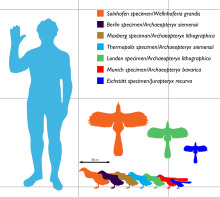Wellnhoferia
| Wellnhoferia | |
|---|---|

| |
| The type specimen | |
| Scientific classification | |
| Domain: | Eukaryota |
| Kingdom: | Animalia |
| Phylum: | Chordata |
| Clade: | Dinosauria |
| Clade: | Saurischia |
| Clade: | Theropoda |
| Family: | †Archaeopterygidae |
| Genus: | †Wellnhoferia Elżanowski, 2001 |
| Species | |
| |
Wellnhoferia (named after Peter Wellnhofer) is a genus of early prehistoric bird-like theropod dinosaur closely related to Archaeopteryx. It lived in what is now Germany, during the Late Jurassic. While Wellnhoferia was similar to Archaeopteryx, it had a shorter tail and its fourth toe was shorter than in Archaeopteryx. Andrzej Elżanowski (2001) of the Institute of Zoology of the University of Wrocław, Poland, determined the differences resulted from a "phylogenetic reduction rather than individual variation."[1]

The type specimen is the Solnhofen Specimen of Archaeopteryx (BSP 1999). Discovered in the 1960s near Eichstätt, Germany and described in 1988 by Wellnhofer (as a specimen of Archaeopteryx),[2] it is currently located at the Bürgermeister-Müller-Museum in Solnhofen. It was originally classified as a Compsognathus by an amateur collector.
Although Elżanowski found significant differences between Wellnhoferia and Archaeopteryx, a 2007 study by Mayr et al. [3] found Wellnhoferia was a specimen of Archaeopteryx lithographica. Senter and Robins (2003), however, supported Elżanowski's naming of a new genus.[4]
References
- ^ Elżanowski, Andrzej (2001). "A new genus and species for the largest specimen of Archaeopteryx" (PDF). Acta Palaeontologica Polonica. 46 (4): 519–532.
- S2CID 32015255.
- ]
- S2CID 85067334.
